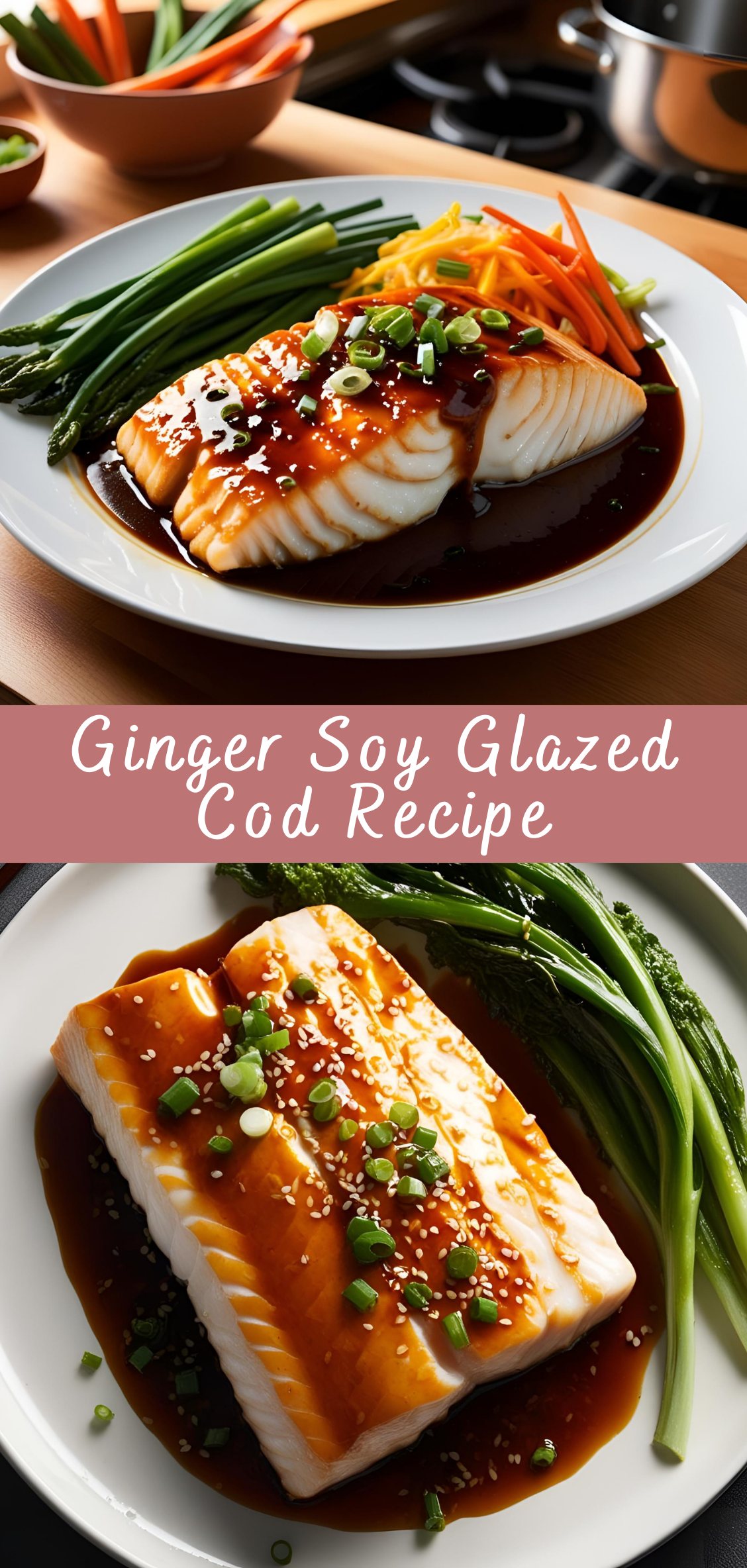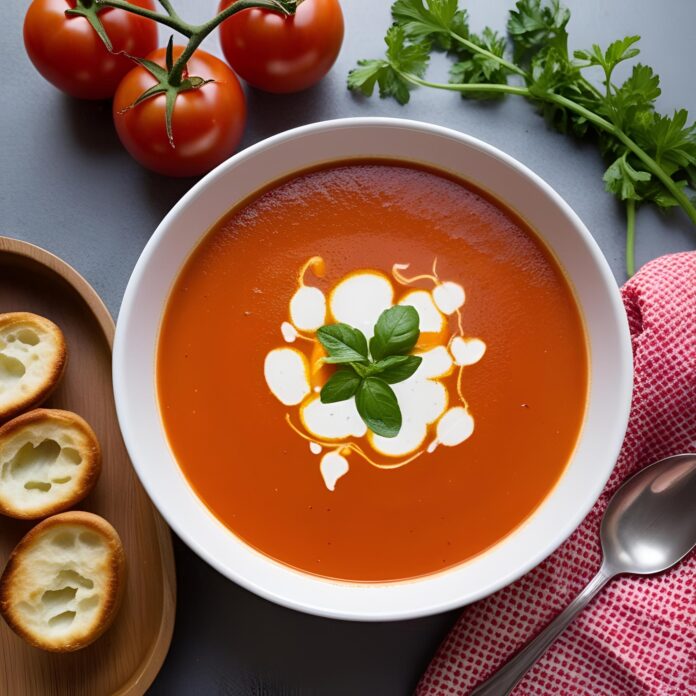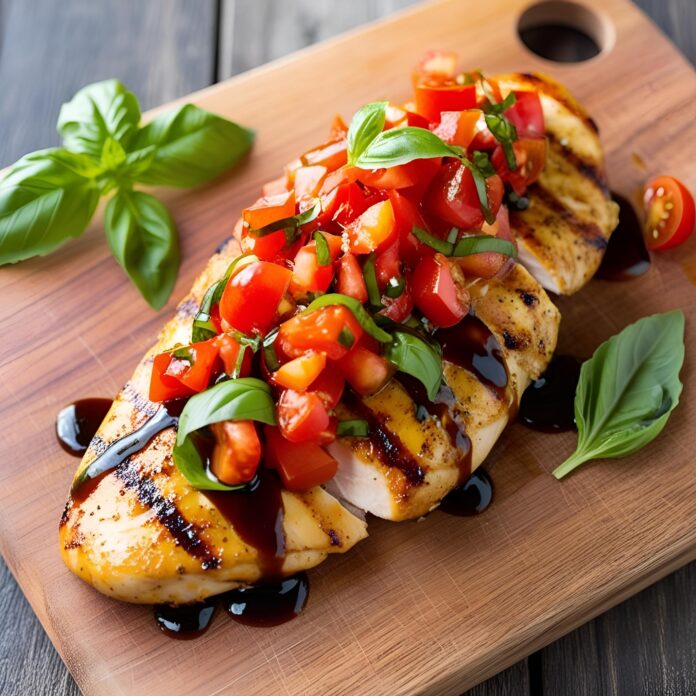Ginger Soy Glazed Cod Recipe
Cod, with its mild flavor and delicate, flaky texture, is an ideal fish for absorbing flavorful marinades and glazes. Its subtle taste allows the zesty, savory, and slightly sweet combination of ginger and soy to shine through without being overwhelming. The texture of cod holds up well to cooking methods like pan-searing or baking, which enhances the glaze while maintaining a moist, tender fillet.

The pairing of ginger and soy with fish is common in many Asian cuisines, offering a perfect balance of flavors: ginger provides warmth and depth, while soy sauce brings umami, saltiness, and savory richness to the dish. Together, they make a flavor-packed glaze that coats the fish beautifully.
The Popularity of Asian-Inspired Fish Dishes
Asian-inspired seafood dishes have grown in popularity across the globe, thanks to the flavors’ bold, aromatic nature. Dishes like teriyaki-glazed salmon, miso-glazed cod, and other soy-based glazes are a staple in many home kitchens and fine dining restaurants. These dishes bring together a harmonious blend of sweet, salty, and savory flavors that elevate the natural taste of the fish.
Ginger and soy sauce are also incredibly versatile, pairing well not only with cod but also with other seafood like shrimp, scallops, or tuna. The dish has become a favorite due to its combination of simple ingredients and sophisticated flavor.
Health Benefits of Cod and Ginger
Cod is a nutritious fish that’s low in fat and high in protein, making it an excellent choice for a healthy, satisfying meal. It is rich in essential nutrients like omega-3 fatty acids, B vitamins (especially B12), and minerals like phosphorus and selenium.
Ginger, on the other hand, has been celebrated for its medicinal properties for centuries. It’s known for its ability to reduce inflammation, aid digestion, and boost immunity. Additionally, ginger’s natural spice helps in digestion and can soothe the stomach, making it a fantastic complement to fish.
Preparation
Selecting the Right Cod Fillets
Fresh cod fillets are always the best option when making this dish, as they tend to have a mild, delicate flavor and a moist texture when cooked. However, frozen cod can work as well, provided you properly thaw it before cooking. When selecting cod, look for fillets that are firm to the touch, with a clean, fresh smell. The flesh should be translucent or slightly opaque, with no discoloration.
Preparing the Ginger Soy Marinade
-
In a bowl, combine the soy sauce, grated ginger, minced garlic, honey, rice vinegar, and sesame oil. Stir the ingredients together to create a smooth marinade.
-
Optional: Add chili flakes or fresh chili to the marinade for extra heat.
-
Taste the marinade and adjust the sweetness or saltiness. Add more honey if you prefer a sweeter glaze or more soy sauce for a saltier one.
Prepping the Cod for Cooking
-
Pat the cod fillets dry with a paper towel. This helps achieve a nice sear on the fish.
-
Season the fillets lightly with salt and pepper. While the marinade will provide much of the flavor, a little seasoning on the fish itself will enhance its natural taste.
-
Set the fillets aside while you prepare the glaze and cooking setup.
Step-by-Step Instructions
Step 1: Marinating the Cod
-
Marinate the Cod: Place the cod fillets in a shallow dish or a resealable plastic bag. Pour the ginger soy marinade over the fish, ensuring that each fillet is coated evenly.
-
Marinate: Cover the dish or seal the bag, then refrigerate the cod for 15-30 minutes. Marinating the fish allows it to absorb the flavors of the ginger soy glaze and results in a more flavorful dish.
Step 2: Preparing the Glaze
-
Prepare the Glaze: While the fish is marinating, pour the remaining marinade (if any) into a small saucepan. Bring it to a simmer over medium heat, stirring occasionally.
-
Thicken the Glaze: Mix the cornstarch with water in a small bowl to create a slurry. Add this mixture to the saucepan and whisk it into the marinade. Allow it to simmer for another 2-3 minutes until the glaze thickens to your desired consistency. If the glaze becomes too thick, add a bit more water to loosen it.
-
Taste the Glaze: Once thickened, taste the glaze and adjust the seasoning if necessary. If you want it sweeter, add a little more honey; if you want it saltier, add more soy sauce.
Step 3: Cooking the Cod Fillets
-
Heat the Skillet: Place a large skillet over medium-high heat and add a splash of oil. Allow the pan to heat up before adding the fish. This will help create a nice sear on the cod.
-
Cook the Cod: Add the marinated cod fillets to the pan. Cook for 3-4 minutes on each side, or until the fish is golden brown and easily flakes with a fork. Avoid overcooking, as cod can dry out quickly.
-
Apply the Glaze: During the last minute of cooking, brush the cod fillets with the prepared glaze, allowing it to caramelize slightly on the fish.
Step 4: Glazing and Serving the Cod
-
Final Glaze: Once the cod is cooked through, remove it from the pan and transfer it to serving plates. Brush with more of the glaze for an extra layer of flavor.
-
Garnish: Sprinkle the cod with toasted sesame seeds, sliced scallions, or fresh herbs of your choice.
-
Serve Immediately: Serve the Ginger Soy Glazed Cod with your choice of side dishes.
Flavor Enhancements
How to Balance the Sweet, Salty, and Umami Flavors
The key to a successful ginger soy glaze is balancing the three main flavors—sweet, salty, and umami. Cod is delicate, so the glaze should complement, not overpower, the fish. Taste the glaze as you cook it, and adjust the sweetness by adding honey or sugar, or adjust the saltiness by adding a bit more soy sauce. If it becomes too salty, you can balance it with vinegar or lime juice.
Incorporating Herbs and Spices for Added Depth
You can experiment with adding different herbs and spices to the glaze or as a garnish. Fresh basil, cilantro, or mint can bring brightness to the dish, while a dash of five-spice powder, star anise, or cinnamon can add an interesting aromatic depth to the glaze.
The Role of Acidity and Heat
Adding a touch of acid from vinegar or lime juice helps balance the richness of the glaze and brings brightness to the overall dish. If you enjoy a bit of heat, fresh chili or chili flakes can spice up the glaze, complementing the natural sweetness of the honey.
Serving Suggestions
Best Side Dishes to Pair with Ginger Soy Glazed Cod
-
Steamed Jasmine Rice: The soft, fragrant rice pairs perfectly with the bold flavors of the cod and helps balance the richness of the glaze.
-
Vegetable Stir-Fry: A mix of vegetables like bell peppers, bok choy, and carrots sautéed with ginger and garlic complements the dish.
-
Sautéed Greens: Lightly sautéed spinach, kale, or bok choy adds a healthy and flavorful side that pairs well with the rich, umami glaze.
-
Pickled Vegetables: A side of quick-pickled vegetables like cucumbers or radishes can provide a tangy contrast to the sweet and savory cod.
Garnishes to Elevate the Dish
-
Toasted Sesame Seeds: For crunch and visual appeal.
-
Fresh Herbs: A sprinkle of cilantro or mint adds freshness.
-
Chili Flakes: For a spicy kick.
Wine and Beverage Pairings
-
White Wine: A crisp white wine like Sauvignon Blanc or Pinot Grigio pairs well with the delicate flavors of cod.
-
Green Tea: A cup of warm green tea balances the flavors of the fish while offering a calming and refreshing taste.
Reheating Instructions
Reheat the cod in the oven at 350°F (175°C) for about 10-15 minutes, or in the microwave for 1-2 minutes. Reheat the glaze separately on the stovetop and drizzle over the fish before serving.
Variations and Customizations
Grilled vs. Pan-Seared Cod
Grilling cod fillets adds a smoky flavor and slightly crispy texture. You can use the same marinade and glaze for grilling. Just make sure to oil the grill grates to prevent the fish from sticking.
Substituting Cod with Other Fish
Cod works well with this ginger soy glaze, but you can substitute other mild, flaky fish like halibut, haddock, or tilapia. You can even try this glaze with salmon for a richer, more flavorful dish.
Gluten-Free and Other Diet-Friendly Options
To make this recipe gluten-free, use tamari sauce instead of soy sauce. You can also replace honey with maple syrup or agave nectar for a vegan version of the glaze.
Troubleshooting Common Mistakes
Dealing with Overcooked Cod
Cod is delicate and cooks quickly, so be mindful of timing. If the fillets are overcooked, they will be dry and tough. Keep an eye on them while cooking, and test with a fork to ensure they are perfectly flaky but moist.
Adjusting the Glaze Consistency
If your glaze is too thick, simply thin it out with a bit of water. If it’s too thin, simmer it longer to reduce and concentrate the flavors.
Preventing Fish from Sticking to the Pan
Make sure the pan is preheated, and use enough oil to create a non-stick surface. You can also coat the fish lightly with flour before cooking to create a protective layer.
Conclusion
Ginger Soy Glazed Cod is a flavorful and healthy dish that combines the delicate taste of cod with the bold, aromatic flavors of ginger and soy sauce. By following the steps and tips provided, you can create a meal that’s both delicious and visually stunning. Whether you’re serving it for a weeknight dinner or an elegant gathering, this dish is sure to impress. With its versatility, you can customize it to suit your preferences, making it a perfect go-to recipe for any occasion.
Ginger Soy Glazed Cod Recipe
Cod, with its mild flavor and delicate, flaky texture, is an ideal fish for absorbing flavorful marinades and glazes. Its subtle taste allows the zesty, savory, and slightly sweet combination of ginger and soy to shine through without being overwhelming. The texture of cod holds up well to cooking methods like pan-searing or baking, which enhances the glaze while maintaining a moist, tender fillet.
Ingredients
- For the Ginger Soy Glaze:
- 1/4 cup soy sauce (or tamari for gluten-free)
- 2 tablespoons honey or maple syrup
- 1 tablespoon rice vinegar (or white wine vinegar)
- 1 tablespoon fresh ginger, grated or minced
- 2 cloves garlic, minced
- 1 tablespoon sesame oil
- 1 teaspoon cornstarch (optional, for thicker glaze)
- For the Cod:
- 4 cod fillets (about 6 oz each)
- 1 tablespoon olive oil or vegetable oil
- Salt and pepper to taste
- Sliced green onions (for garnish)
- Sesame seeds (for garnish)
- Fresh cilantro (optional, for garnish)
Instructions
1. Prepare the Ginger Soy Glaze:
- In a small saucepan, combine the soy sauce, honey (or maple syrup), rice vinegar, grated ginger, garlic, and sesame oil.
- Bring the mixture to a simmer over medium heat. Stir occasionally and let it cook for 3-5 minutes, allowing the flavors to meld.
- If you want a thicker glaze, mix the cornstarch with a tablespoon of water in a small bowl and add it to the saucepan. Stir well and let the glaze simmer for another 1-2 minutes until it thickens. Remove from heat and set aside.
2. Cook the Cod:
- Pat the cod fillets dry with paper towels and season both sides with a little salt and pepper.
- Heat the olive oil in a large skillet over medium-high heat. Once the oil is hot, carefully place the cod fillets in the skillet.
- Cook the cod for about 3-4 minutes per side, or until golden brown and cooked through. Cod is done when it easily flakes with a fork.
3. Glaze the Cod:
- Once the cod fillets are cooked, pour the ginger soy glaze over the fillets in the skillet. Allow the glaze to heat up for about 1-2 minutes, spooning it over the fish for an even coating.
4. Serve:
- Transfer the glazed cod fillets to serving plates. Garnish with sliced green onions, sesame seeds, and fresh cilantro (if desired).
- Serve with steamed rice, sautéed vegetables, or a fresh salad for a complete meal.
Notes
- Cod Substitution: You can substitute the cod with other firm white fish like halibut, snapper, or tilapia if preferred.
- Gluten-Free Option: Use tamari instead of soy sauce and check the honey for any additives that may not be gluten-free.
- Sweetness Level: Adjust the sweetness of the glaze by adding more honey or reducing the amount depending on your taste preference.
- Make It Spicy: Add a pinch of red pepper flakes or a dash of sriracha to the glaze for a spicy kick.



